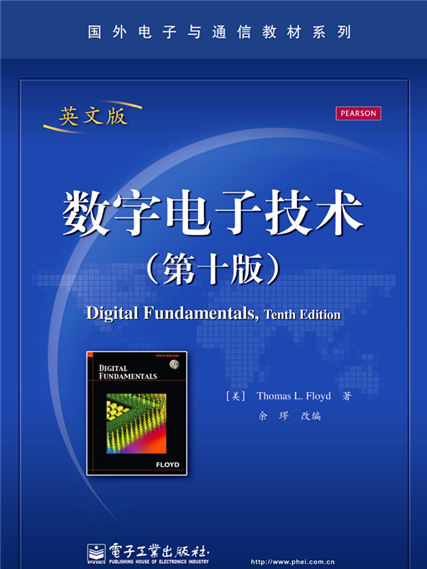《數字電子技術(第十版)(英文版)》是2011年10月電子工業出版社出版的圖書,作者是余璆。
基本介紹
- 中文名:數字電子技術(第十版)(英文版)
- 作者:余璆
- 出版社:電子工業出版社
- 出版時間:2011年10月
- 頁數:576 頁
- 定價:59.8 元
- 開本:16 開
- ISBN:9787121132575

《數字電子技術(第十版)(英文版)》是2011年10月電子工業出版社出版的圖書,作者是余璆。
《數字電子技術(第十版)(英文版)》是2011年10月電子工業出版社出版的圖書,作者是余璆。內容簡介本書是一本關於數字電子技術的經典教材,並專門針對國內教學的實際情況進行了縮減。全書主要介紹了數字電子技術的基本概念、數制...
《數字電子技術英文學習指導》是2016年7月19日機械工業出版社出版的圖書,作者是張虹。內容簡介 本書是為配合數字電子技術雙語和全英文教學的需要而編寫的,主要與Thomas L. Floyd主編的《Digital Fundamentals》配套使用,也可用於其他英文...
《數字電子技術第九版英文改編版》是2006年電子工業出版社出版的圖書,作者是弗洛伊德、余璆。內容簡介 本書是關於數字電子技術的經典教材,內容涉及數字電子的基本概念、數制、邏輯門、布爾代數和邏輯化簡、組合邏輯分析、組合邏輯的作用、...
《普通高等教育“十一五”規劃教材:數字電子技術基礎》是中國電力出版社出版的書籍。內容簡介 《普通高等教育“十一五”規劃教材:數字電子技術基礎》共分為四篇13章,主要內容包括數字電路基礎篇、組合邏輯電路篇、時序邏輯電路篇以及數字...
《數字電子技術》2013年東南大學出版社出版的圖書,作者:郭永貞, 許其清, 龔克西,本書精選了傳統數字電子技術巾有套用價值的內容,引入了現代新型邏輯器件、新技術及新的分析與設計方法,特別加強了可程式邏輯器件及其編程設計、VHDL語言等...
《數字電子技術(第三版)》是2011年2月電子工業出版社出版的圖書,作者是高吉祥。內容簡介 本書是依據教育部“電子信息科學與電氣信息類基礎課程教學基本要求”編寫的。主要內容有:數字邏輯基礎,邏輯門電路,組合邏輯電路,觸發器,時序...
《數字電子技術(第2版)》是2022年7月1日清華大學出版社出版的圖書,作者是李承、徐安靜。內容簡介 《數字電子技術(第2版)/高等學校電子信息類專業系列教材》系統地介紹了數字電子技術的基本原理與邏輯電路分析設計方法。主要內容...
《數字電子技術基礎(第5版)》是2006年5月高等教育出版社出版的圖書,作者是閻石、清華大學電子學教研組。內容簡介 本書是普通高等教育“十五”國家級規劃教材。本書以前各版曾分別獲得北京市教育教學成果一等獎、國家教委優秀教材一等獎、...
《數字電子技術基礎(第2版)》是2015年2月1日電子工業出版社出版的圖書,作者是張寶榮。內容簡介 本書為高等學校“十二五”電氣自動化類規劃教材之一,也是燕山大學的“數字電子技術基礎”河北省精品課程配套教材,是根據近年來數字電子...
《數字電子技術(第3版)》是2021年3月高等教育出版社出版的圖書,作者是黃潔,本書可作為高等職業院校電氣電子等相關專業的教學用書, 也可作為社會從業人士的業務參考書及培訓用書。內容簡介 本書通過8個工作任務的引領,主要介紹數字電...
2018年3月23日,《數字電子技術(第5版)》由高等教育出版社出版發行。項目入選 2020年12月8日,《數字電子技術(第5版)》入選中華人民共和國教育部辦公廳“十三五”職業教育國家規劃教材書目。內容簡介 該書共分十章,分別為緒論、...
《數字電子技術項目教程(第3版)》是2017年電子工業出版社出版的圖書,作者是謝蘭清、黎藝華。內容簡介 本書依據《數字電子技術》教學大綱的要求,以數字電子技術中的典型項目為載體,將教學內容按項目模組編寫,全書的內容包括:簡單搶答...
《數字電子技術基礎(第六版)》是由閻石主編、高等教育出版社2016年出版的教材,可作為高等院校電氣類、電子信息類、自動化類、儀器儀表類各專業的教材,也可供其他理工科專業選用或供社會讀者閱讀。全書由數制和碼制、邏輯代數基礎、門...
《數字電子技術(第四版)》是2014年大連理工大學出版社出版的圖書,作者是李妍。內容簡介 《數字電子技術》(第四版)是新世紀高職高專教材編審委員會組編的電氣自動化技術專業系列規劃教材之一。 根據國家教育事業“十二五”規劃(職...
《數字電子技術(第四版)(江曉安)“十一五”》是2016年西安電子科技大學出版社出版的圖書,作者是江曉安、周慧鑫。內容簡介 本書為第四版,是在普通高等教育“十一五”國家級規劃教材(第三版)的基礎上修訂而成的,內容更加簡明、...
本書是依據教育部“電子技術基礎課程教學基本要求(1995年修訂版)”編寫的。主要內容包括數字電路基礎,邏輯門電路、組合邏輯電路、觸發器、時序邏輯電路、存儲器和可程式邏輯器件、ADC和DAC、數字積體電路的典型套用、數字電子電路讀圖及...
《現代數字電子技術基礎實踐第2版》是2023年機械工業出版社出版的圖書,作者是陳龍、牛小燕、馬學條、楊柳。內容簡介 本書是浙江省普通本科高校‘十四五’重點教材”,主要內容包括:數字電路實驗基本知識、數字電路與邏輯設計基本實驗、電路...
